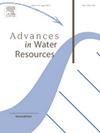Dupuit-Forchheimer从沿海含水层提取海水的解决方案
IF 4.2
2区 环境科学与生态学
Q1 WATER RESOURCES
引用次数: 0
摘要
海水入侵可以通过抽取咸水来缓解,形成一个负水力屏障,减少沿海含水层的咸水范围。本研究通过基于锐界面稳态条件的半解析方法分析了海水抽提的影响。该方法基于Dupuit-Forchheimer近似,并应用幂级数方法来获得含水层海水范围的精确解。或者,可以通过龙格-库塔法获得溶液,从而可以快速评估海水抽取在简单情况下的效果(例如,均匀、均质含水层和连续线下沉井)。与使用SEAWAT的数值模拟(包括名义上为零弥散和有弥散的情况)的比较显示,使用改进密度的锐利界面溶液与SEAWAT的50%海水等高线之间具有良好的一致性。结果表明,对于给定的井位,存在一个最佳(最大)海水提取率,使海水向陆地的范围最小。同样,对于给定的采收率,存在一个最佳井位。这些最佳方案将井置于海水-淡水界面,因此在实践中可能会导致部分淡水的提取。尽管如此,它们代表了在无量纲参数空间中定义负液压屏障工作区域的限制,从而可以为有关适用性的初步决策提供信息。该方法提供了一种快速评估工具,用于检查抽采井位置与抽采速率之间的相互作用。本文章由计算机程序翻译,如有差异,请以英文原文为准。
A Dupuit-Forchheimer solution to the extraction of seawater from coastal aquifers
Seawater intrusion can be mitigated by extracting saltwater, creating a negative hydraulic barrier that reduces the extent of saltwater in coastal aquifers. The effects of seawater extraction are analyzed in the current study through a semi-analytical methodology based on sharp-interface, steady-state conditions. The methodology is based on the Dupuit-Forchheimer approximation and applies a power series approach to obtain an exact solution to the seawater extent in the aquifer. Alternatively, the solution can be obtained by a Runge-Kutta method, thereby allowing for rapid assessment of the efficacy of seawater extraction for simple situations (e.g., uniform, homogeneous aquifer, and a continuous line sink well). Comparisons with numerical simulations using SEAWAT (including cases with nominally zero dispersion and with dispersion) display good agreement between the sharp-interface solution using a modified density and the 50 % seawater contour from SEAWAT. The results show that for a given well location there is an optimal (maximum) extraction rate of seawater that minimises the landward extent of seawater. Equivalently, for a given extraction rate, there is an optimal well location. These optima place a well at the seawater-freshwater interface, so in practice will likely lead to the partial extraction of freshwater. Nonetheless, they represent the limits defining the operating region for a negative hydraulic barrier in non-dimensional parameter space and thereby can inform initial decisions regarding applicability. The method presented provides a rapid assessment tool for examining the interplay between the extraction well location and the extraction rate.
求助全文
通过发布文献求助,成功后即可免费获取论文全文。
去求助
来源期刊

Advances in Water Resources
环境科学-水资源
CiteScore
9.40
自引率
6.40%
发文量
171
审稿时长
36 days
期刊介绍:
Advances in Water Resources provides a forum for the presentation of fundamental scientific advances in the understanding of water resources systems. The scope of Advances in Water Resources includes any combination of theoretical, computational, and experimental approaches used to advance fundamental understanding of surface or subsurface water resources systems or the interaction of these systems with the atmosphere, geosphere, biosphere, and human societies. Manuscripts involving case studies that do not attempt to reach broader conclusions, research on engineering design, applied hydraulics, or water quality and treatment, as well as applications of existing knowledge that do not advance fundamental understanding of hydrological processes, are not appropriate for Advances in Water Resources.
Examples of appropriate topical areas that will be considered include the following:
• Surface and subsurface hydrology
• Hydrometeorology
• Environmental fluid dynamics
• Ecohydrology and ecohydrodynamics
• Multiphase transport phenomena in porous media
• Fluid flow and species transport and reaction processes
 求助内容:
求助内容: 应助结果提醒方式:
应助结果提醒方式:


